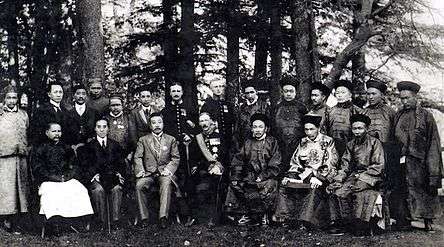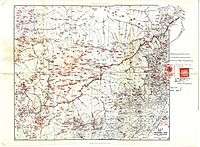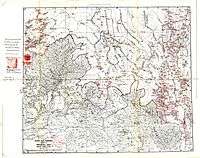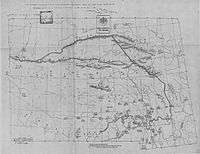Simla Convention
The Simla Convention, or the Convention Between Great Britain, China, and Tibet, [in] Simla,[1] was an ambiguous[2] treaty concerning the status of Tibet negotiated by representatives of the Republic of China, Tibet and Great Britain in Simla in 1913 and 1914.

The Simla Convention provided that Tibet would be divided into "Outer Tibet" and "Inner Tibet". Outer Tibet, which roughly corresponded to Ü-Tsang and western Kham, would "remain in the hands of the Tibetan Government at Lhasa under Chinese suzerainty", but China would not interfere in its administration. "Inner Tibet", roughly, equivalent to Amdo and eastern Kham, would be under the jurisdiction of the Chinese government. The convention with its annexes also defines the boundary between Tibet and China proper and that between Tibet and British India (the latter to be known as the McMahon Line).[1][3][lower-alpha 1]
A draft convention was initialled by all the three countries on 27 April 1914, but China immediately repudiated it.[4][5] A slightly revised convention was signed again on 3 July 1914, but only by Britain and Tibet. The Chinese plenipotentiary, Ivan Chen, declined to sign it.[5][6] The British and Tibetan plenipotentiaries then attached a bilateral declaration to the effect that the convention would be binding on themselves and that China would be denied any privileges under the convention.[7][8]
McMahon's work was initially rejected by the British government as incompatible with the 1907 Anglo-Russian Convention. The latter was renounced in 1921. The British began using the McMahon Line on Survey of India maps in 1937, and the Simla Convention was published officially in 1938.[lower-alpha 2]
Background
Early British efforts to create a boundary for north-east India were triggered by their discovery in the mid-19th century that Tawang, an important trading town, was Tibetan territory.[9] Britain had concluded treaties with Qing China concerning Tibet's boundaries with Burma[10] and Sikkim.[11] However, Tibet refused to recognise the boundaries drawn by these treaties. British forces led by Sir Francis Younghusband entered Tibet in 1904 and made a treaty with the Tibetans.[12] In 1907, Britain and Russia acknowledged Chinese "suzerainty" over Tibet.[13]
British interest in the borderlands was renewed when the Qing government sent military forces to establish a Chinese administration in Tibet (1910–12). A British military expedition was sent into what is now Arunachal Pradesh and the North-East Frontier Agency was created to administer the area (1912). In 1912–13, this agency reached agreements with the tribal leaders who ruled the bulk of the region.[14] After the fall of the Qing dynasty in China, the Tibet government at Lhasa expelled all Chinese forces and declared itself independent (1913),[15][16] however, this was not accepted by the newly founded Republic of China.[17]
Conference
In 1913, the British convoked a conference at Viceregal Lodge in Simla, India to discuss the issue of Tibet's status.[18] The conference was attended by representatives of Britain, the newly founded Republic of China, and the Tibetan government at Lhasa.[1] The British plenipotentiary, Sir Henry McMahon, introduced the plan of dividing Tibetan-inhabited areas into "inner Tibet" and "outer Tibet" and apply different policies. "Inner Tibet", which includes Tibetan-inhabited areas in Qinghai, Gansu, Sichuan and Yunnan provinces, would be under the jurisdiction of the Chinese government. "Outer Tibet", covering approximately the same area as the modern "Tibet Autonomous Region" would enjoy autonomy. A boundary between Tibet and British India, later called the McMahon Line, was drawn on a map referred to in the treaty.[3]
The Tibetan Indian boundary was negotiated in Simla between representatives from Britain and Tibet privately, in the absence of the Chinese representative. During the Simla conference a map of the Tibetan Indian border was provided as an annexe to the proposed agreement.[9][18][lower-alpha 1][lower-alpha 3]
The Schedule appended to the Convention contained further notes. For example, it was to be understood that "Tibet forms part of Chinese territory" and after the Tibetans selected a Dalai Lama, the Chinese government was to be notified and the Chinese commissioner in Lhasa would "formally communicate to His Holiness the titles consistent with his dignity, which have been conferred by the Chinese Government"; that the Tibetan government appointed all officers for "Outer Tibet", and that "Outer Tibet" was not to be represented in the Chinese Parliament or any such assembly.[1][19]
Negotiations failed when China and Tibet could not agree over the Sino-Tibetan boundary.[20] After the Chinese plenipotentiary, Ivan Chen, withdrew from the convention, the British and Tibetan plenipotentiaries attached a note denying China any privileges under the agreement and signed it as a bilateral declaration.[19] At the same time the British and Lochen Shatra signed a fresh set of trade Regulations to replace those of 1908.[21]
Aftermath
Simla was initially rejected by the Government of India as incompatible with the 1907 Anglo-Russian Convention. The official treaty record, C.U. Aitchison's A Collection of Treaties, was published with a note stating that no binding agreement had been reached at Simla.[22] Since the condition (agreement with China) specified by the accord was not met, the Tibetan government didn't agree with the McMahon Line.[23]
The Anglo-Russian Convention was renounced by Russia and Britain jointly in 1921,[24] but the McMahon Line was forgotten until 1935, when interest was revived by civil service officer Olaf Caroe.[25] The Survey of India published a map showing the McMahon Line as the official boundary in 1937.[25] In 1938, the British published the Simla Convention in Aitchison's Treaties.[22][26] A volume published earlier was recalled from libraries and replaced with a volume that includes the Simla Convention together with an editor's note stating that Tibet and Britain, but not China, accepted the agreement as binding.[27] The replacement volume has a false 1929 publication date.[22]
In April 1938, a small British force led by Captain G. S. Lightfoot arrived in Tawang and informed the monastery the district was now Indian territory.[28] The Tibetan government protested and its authority was restored after Lightfoot's brief stay. The district remained in Tibetan hands until 1951.
Tibetan response
The British records show that the Tibetans did not agree to the new Indo-Tibetan border without obtaining the Chinese acceptance of the Simla Convention. Since the British were unable to obtain the Chinese accpetance, Alastair Lamb states that the Tibetans regarded the McMahon Line invalid.[23]
Sino-Indian disputes in 1950
In the late 1950s, the McMahon Line became a source of tension between China and India.[29] China contends that Tibet was never an independent state and so it could not sign a treaty on behalf of China to delineate an international frontier.[30] China and India fought the Sino-Indian War in 1962, which nevertheless preserved the status quo ante bellum. Australian journalist and historian Neville Maxwell exposed a top-secret Indian war report that harshly criticised the highest echelons of power in India at the time for pursuing a flawed strategy of provoking China into the war without the means to handle a backlash. The so-called Henderson Brooks-Bhagat Report was an operational review of India's military debacle commissioned by New Delhi that Maxwell managed to obtain. Compiled by Lieutenant-General Henderson Brooks and Brigadier Premindra Singh Bhagat in 1963, it has been kept secret by the Indian government despite repeated appeals that it be declassified.[31][32] Years later, the area, then known as the North-East Frontier Agency, gained Indian statehood as Arunachal Pradesh.[33]
2008 British policy change
Until 2008 the British Government's position remained the same that China held suzerainty over Tibet but not full sovereignty. It was the only state still to hold this view.[34] David Miliband, the British Foreign Secretary, described the old position as an anachronism originating in the geopolitics of the early 20th century.[35] Britain revised this view on 29 October 2008, when it recognised Chinese sovereignty over Tibet by issuing a statement on its website.[lower-alpha 4] The Economist stated that although the British Foreign Office's website does not use the word sovereignty, officials at the Foreign Office said "it means that, as far as Britain is concerned, 'Tibet is part of China. Full stop.'"[34]
The British Government sees their new stances as an updating of their position, while some others have viewed it as a major shift in the British position.[lower-alpha 5] Tibetologist Robert Barnett thinks that the decision has wider implications. India's claim to a part of its north-east territories, for example, is largely based on the same agreements – notes exchanged during the Simla convention of 1914, which set the boundary between India and Tibet – that the British appear to have simply discarded.[29] It has been speculated that Britain's shift was made in exchange for China making greater contributions to the International Monetary Fund.[29][36][37]
Maps
 McMahon Line Simla Accord Treaty 1914 Map 1
McMahon Line Simla Accord Treaty 1914 Map 1 McMahon Line Simla Accord Treaty 1914 Map 2
McMahon Line Simla Accord Treaty 1914 Map 2 Simla Accord,treaty signed in 1914, Map 1
Simla Accord,treaty signed in 1914, Map 1 Simla Accord,treaty signed in 1914, Map 2
Simla Accord,treaty signed in 1914, Map 2
See also
- Unequal treaties
- Treaty of Kyakhta (1915)
- Imperialism in Asia
Notes
- The map was finalised on 24/25 March 1914 by the British and Tibetan plenipotentiaries. Indian sources currently claim that, on being informed of the line, the Chinese plenipotentiary did not express any disagreement.[3]
The two maps (27 April 1914 and 3 July 1914) illustrating the boundaries bear the full signature of the Tibetan Plenipotentiary; the first bears the full signature of the Chinese Plenipotentiary also; the second bears the full signatures along with seals of both Tibetan and British Plenipotentiaries. (V. Photographic reproductions of the two maps in Atlas of the North Frontier of India, New Delhi: Ministry of External Affairs 1960)
(Goldstein (1991), p. 80 quotes the India Office records IOR/L/PS/10/344).The Indian Government opened bilateral negotiations with the Tibetans in Deli in February–March 1914 (the conferees having retreated from the Simla winter) with the object of securing Tibetan agreement to the proposed alignment.
— Gupta, Karunakar, The McMahon Line 1911–45: The British Legacy - Smith (1996), p. 201 (note 163), Smith (2019), p. 212 (note 163): "The Simla Convention and its appended Indo-Tibetan agreement did not appear in Aitchison's Treaties (the official GOI record), including the final 1929 edition, since the unratified Simla Convention was not a valid international treaty and the Indo-Tibetan agreement was secret. The 1929 edition was withdrawn by a British Indian official, Olaf Caroe, in 1938, and a new edition was issued that included the Simla Convention and the McMahon-Shartra notes (but not the Anglo-Tibetan agreement or the McMahon Line map). Lamb, McMahon Line, 546."
- Calvin (1984): "The line was marked on a large-scale (eight miles to the inch) map. On a much smaller-scale map, which was used in the discussions of the Inner Tibet-Outer Tibet boundary, the McMahon-Tibetan boundary (which would become the McMahon Line) was shown as a sort of appendix to the boundary between Inner Tibet and China proper (see Map Six,below)."
- Miliband, David, "Written Ministerial Statement on Tibet (29/10/2008)", British Foreign Office website, archived from the original on 2 December 2008: "Our ability to get our points across has sometimes been clouded by the position the UK took at the start of the 20th century on the status of Tibet, a position based on the geo-politics of the time. Our recognition of China's "special position" in Tibet developed from the outdated concept of suzerainty. Some have used this to cast doubt on the aims we are pursuing and to claim that we are denying Chinese sovereignty over a large part of its own territory. We have made clear to the Chinese Government, and publicly, that we do not support Tibetan independence. Like every other EU member state, and the United States, we regard Tibet as part of the People's Republic of China. Our interest is in long term stability, which can only be achieved through respect for human rights and greater autonomy for the Tibetans."
- Lunn (2009), p. 7: "However, in October 2008 there was what some have viewed as a major shift in the British position, although the Government sees it more as an updating of it. This involved abandoning the concept of 'Chinese suzerainty' on the grounds that it was unclear and out-dated."
References
Citations
- "Convention Between Great Britain, China, and Tibet, Simla (1914)", Tibet Justice Center. Retrieved 20 March 2009
- Hoffmann 1990, p. 19: "McMahon's achievement seemed substantial at the time, but its meaning proved to be ambiguous at best."
- Sinha (1974), p. 12
- Banerji, Borders (2007), p. 201.
- Hoffmann (1990), p. 19.
- Mehra (1972), p. 299: "Ivan Chen, who had initialed the first earlier in April, kept his own counsel."
- Hoffmann (1990), p. 19: "The Simla Convention itself was initialed again by the British and Tibetan conference leaders in Delhi on 3 July 1914, and they signed a joint declaration pronouncing the convention binding upon themselves, even without Chinese agreement."
- Mehra (1972), p. 299: "A joint British-Tibetan declaration stipulating that its terms would apply to China only when the latter fell in line with its two other signatories was attached to the Convention."
- Calvin, James Barnard, "The China-India Border War", Marine Corps Command and Staff College, April 1984
- Convention Relating to Burmah and Tibet (1886), Tibet Justice Center Archived 10 March 2009 at the Wayback Machine
- "Convention Between Great Britain and China Relating to Sikkim and Tibet (1890)", Tibet Justice Center Archived 10 March 2009 at the Wayback Machine. Retrieved 20 March 2009
- "Convention Between Great Britain and Tibet (1904)", Tibet Justice Center Archived 10 March 2009 at the Wayback Machine. Retrieved 20 March 2009
- Convention Between Great Britain and Russia (1907) Article II, Tibet Justice Center Archived 10 March 2009 at the Wayback Machine
- See North East Frontier of India (1910 & 1911 editions).
- Goldstein (1997), pp. 30–31
- "Proclamation Issued by His Holiness the Dalai Lama XIII (1913)", Tibet Justice Center Archived 10 March 2009 at the Wayback Machine. Retrieved 20 March 2009
- Smith (1996), pp. 182–183
- Maxwell 1970
- Goldstein 1991, p. 75.
- Shakya (1999), p. 5
- McKay, Alex, The History of Tibet: The modern period: 1895–1959, the Encounter with modernity, p. 136.
- Lin, Hsiao-Ting (September 2004), "Boundary, sovereignty, and imagination: Reconsidering the frontier disputes between British India and Republican China, 1914–47", The Journal of Imperial and Commonwealth History, 32 (3): 25–47, doi:10.1080/0308653042000279650
- Shakya (1999), p. 279; Shakya (2012), p. 530: "Since the British were not able to obtain such an acceptance, the Tibetans considered the line proposed by MacMahon invalid.[14: Alastair Lamb, 1989. p. 469]"
- UK relations with Tibet, Free Tibet Campaign. Retrieved 20 March 2009. "... in 1917, the Communist Government in Russia repudiated all the international engagements of the tsars, ... in 1921, the 1907 Treaty was cancelled by agreement."
- Guruswamy, Mohan, "The Battle for the Border", Rediff, 23 June 2003.
- Banerji, Arun Kumar, "China, The British And Tawang", The Statesman, 24 April 2011.
- Schedule of the Simla Convention, 1914 Archived 12 September 2006 at the Wayback Machine
- Goldstein 1991, p. 307.
- Robert Barnett, Did Britain Just Sell Tibet?, The New York Times, 24 November 2008
- Kaiyan Homi Kaikobad Interpretation and Revision of International Boundary, Cambridge University Press, 2007, ISBN 0-521-86912-9, ISBN 978-0-521-86912-6 pp. 36–38
- "Neville Maxwell discloses document revealing that India provoked China into 1962 border war". South China Morning Post. 6 July 2017.
- "Border games. Rectifying an inconvenient history". TibetInfoNet. 8 November 2009. Retrieved 14 August 2010.
- China revives claims on Indian territory IRNA, Islamic Republic News Agency (IRNA No.035 05/04/2005 14:22) republished under the same name, globalsecurity.org,
- Staff, Britain's suzerain remedy, The Economist, 6 November 2008
- Lunn (2009), p. 8.
- Forsyth, James (the web editor of The Spectator). Have Brown and Miliband sold out Tibet for Chinese cash? Archived 3 December 2008 at the Wayback Machine, website of The Spectator, 25 November 2008.
- Editorial The neglect of Tibet, The Daily Telegraph, 11 March 2009.
Sources
- Aitchison, C.U. "Convention Between Great Britain, China, and Tibet, Simla", A Collection of Treaties, Engagements And Sanads, Vol XIV, Calcutta 1929, pp. 21 & 38. (Official British colonial treaty record), on the website of the Tibet Justice Center. Retrieved 2009-03-20
- Banerji, Arun Kumar (2007), "Borders", in Jayanta Kumar Ray (ed.), Aspects of India's International Relations, 1700 to 2000: South Asia and the World, Pearson Education India, pp. 173–256, ISBN 978-81-317-0834-7
- Calvin, James Barnard (Lieutenant Commander,U. S. Navy). The China – India Border War (1962), Marine Corps Command and Staff College, April 1984, republished as The China-India Border War, globalsecurity.org. Retrieved 2009-04-11.
- Lunn, Jon (20 March 2009), Tibet (SN/IA/5018) (PDF), International Affairs and Defence Section, British Parliamentary Briefing Paper, archived from the original (PDF) on 18 June 2009
- Marshall, Julie (2004), Britain and Tibet 1765–1947, Routledge, ISBN 978-1-134-32784-3
- Maxwell, Neville. India's China War (1970) Jonathan Cape. ISBN 0-224-61887-3.
- Goldstein, Melvyn C. (1991), A History of Modern Tibet, 1913–1951: The demise of the Lamaist state, University of California Press, pp. 75, 307, 837, ISBN 978-0-520-07590-0
- Goldstein, Melvyn C. (1997), The Snow Lion and the Dragon: China, Tibet, and the Dalai Lama, University of California Press., pp. 30–31, ISBN 978-0-520-21951-9
- Hoffmann, Steven A. (1990), India and the China Crisis, University of California Press, ISBN 978-0-520-06537-6
- Mehra, Parshotam (February 1972), "A Forgotten Chapter in the History of the Northeast Frontier: 1914-36", The Journal of Asian Studies, 31 (2): 299–308, doi:10.2307/2052598, JSTOR 2052598
- Mehra, Parshotam (1974), The McMahon Line and After: A Study of the Triangular Contest on India's North-eastern Frontier Between Britain, China and Tibet, 1904-47, Macmillan
- Namoyal, Gyalmo Hope; Sherab, Gyaltshen T.; Sinha, Nirmal C (21 February 1966), Bulletin of Tibetology, Vol III, No, 1 (PDF), Gangtok: Namgyal Institute of Tibetology
- Sinha, Nirmal C. (1966), "Was the Simla Convention not signed?" (PDF), Ibid, pp. 33–38
- Shakya, Tsering (1999), The Dragon in the Land of Snows: A History of Modern Tibet Since 1947, Columbia University Press, ISBN 978-0-231-11814-9
- Shakya, Tsering (2012), Dragon in the Land of Snows: The History of Modern Tibet since 1947, Random House, ISBN 978-1-4481-1429-0
- Shakya, Tsering (2012), Dragon In The Land Of Snows: The History of Modern Tibet since 1947, Random House, ISBN 978-1-4481-1429-0
- Sinha, Nirmal C. (1974), "The Simla Convention 1914: A Chinese Puzzle" (PDF), Presidency College Magazine – Diamond Jubilee edition, republished by The Tibetan & Himalayan Library, 1987
- Smith, Warren W. (1996), Tibetan Nation: A history of Tibetan nationalism and Sino-Tibetan relations, Westview Press, ISBN 978-0-8133-3155-3
- Smith, Warren (2019), Tibetan Nation: A history of Tibetan nationalism and Sino-Tibetan relations, Taylor & Francis, ISBN 978-1-00-061228-8
- Staff, "Convention Between Great Britain, China, and Tibet, Simla (1914)", Tibet Justice Center. Retrieved 2009-03-20
External links
| Wikisource has original text related to this article: |
- "Convention Between Great Britain, China, and Tibet, Simla (1914)", Tibet Justice Center Archived 10 March 2009 at the Wayback Machine. Retrieved 20 March 2009